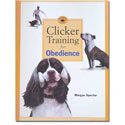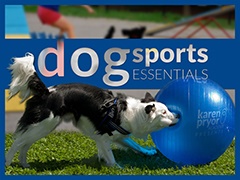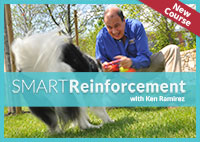Q: I'm training my dog, an English springer spaniel, to do signals for Utility obedience competition.
My dog understands what the sit signal is. When I am close he sits up like a rocket, as I get further he sometimes hesitates, and if too far, doesn't do it at all. If I go back, again he sits up like a rocket.
However, when I go just a bit further, he sits on the signal but moves forward a bit. I have used things to prevent him from moving forward but they only temporarily fix the problem.
I'm looking for some guidance on building a sit signal so my dog eventually understands that I can give the signal when I'm 20 feet away from him. I'm not in a hurry and am willing to build; just not sure I'm going about it right.
A: My guess is that you have used the sit cue thousands of times to mean "sit beside me" or "sit facing me" and that you've refined the behavior to mean "sit here" and also "sit now," "sit fast," "sit square," "keep looking at my face as you sit," etc. Now you want to change one of those rules to mean "sit 20 feet away," not "right at my side/right in front of me," and the dog is confused. He's hesitating. He's changing the behavior by creeping (and probably by other ways, too, trying to find out what you want; moving forward just happens to be the one that's the most obvious and worrisome).
Here's one essential problem that I see cropping up all over the place nowadays, and I think it's my fault. People have learned to use the click to reinforce a behavior, but they have not learned to use the click to reinforce understanding a cue. In this case, you're adding a new criterion: the sit cue also means "sit at a distance."
So here's one way to go at it. Get 50 treats, go to a quiet place, and put six or seven treats in your hand.
Ask the dog a question: Can you sit if I say "sit," while I am facing you sideways? Yes? Click, treat. Toss the treat so the dog has to go get it. Toss it FAST. The easiest way to get a new idea across is to speed up the rate of training so that there's no dead time when the dog is waiting and losing confidence.
As soon as the treat has been swallowed, try again. Click as the dog is moving into the sit, NOT after he's thoroughly parked; you are NOT clicking the behavior, you are clicking "respond to the cue no matter what weird thing I am doing." Give the cue while walking. When he's done a couple of sits even though you were moving as you spoke, move in the other direction. Try saying sit while you're looking at the ceiling. While you're bending backwards a few inches. Over your shoulder. If he pauses instead of sitting, back up a step or two, call him to you, then repeat the word. You can alternate between new poses and your standard "front" pose, to give you plenty of chances to treat for sitting, if you need to; it depends how much history of "just one way" you have to overcome.
While you are doing this, drop all your other criteria. It doesn't matter if the dog sits crooked, sits slowly, sits hesitantly. Catch him in the act of sitting, and give him a new chance right away, and all that other stuff will disappear when he's sure what you mean. If he sits and then creeps forward, you didn't click soon enough; try again and catch him as rump hits ground.
Now, having built a little flexibility into the cue, you can shape for distance, that is, say "sit" while he is a little bit away from you. (Toss treats to get him out from you. Or, stand behind the coffee table so he can't come into "front" before he sits.) You seem to know, already, that there's a distance at which the behavior breaks down. Great. The dog is telling you, "Here's where I get confused." So, work inside that distance, but add other variations, such as turning or stepping toward or away from him. Use the click to explain that "sit" means sit, even 5 feet away. Again, click during the movement, don't wait for him to be parked and doing nothing; he can't learn to do "nothing."
If 5 feet away is the trouble point, click and treat at 4'6", 4'7", 3', 4'10", 5', 4', etc. As Morgan Spector puts it, ping pong around the new criterion. You can use someone else to call the dog away and then you call "(dog's name), sit." Click even the most hesitant sit under this new circumstance, go up to the dog, and treat. Repeat until you get a confident plop!
Then work at longer distances, adding a few inches at a time, facing in different directions, moving your arms and legs so YOU aren't part of the cue, just the word "sit."
If you want to be even more methodical, put masking tape on the floor at one-foot intervals; or use a tiled floor and count the tiles. BUILD a clear understanding that distance, the new variable, doesn't make any difference, sit is still sit.
Sounds like a pain? Not at all. If you do this clearly, in two or three five-minute sessions the dog should truly understand that sit means sit even if you are wiggling, and even if you are not facing him, or not three inches away but 6, 12, 20 inches, 3 feet, 5 feet.
From a few inches to a couple of feet is tough. From a couple of feet to the next sticking point goes fast. Working around the next sticking point, wherever it happens to be, may take a whole five minute session, but once you are through that gate you should be able to go to 10, 15, 20 feet, and beyond in a single session. Go to 40 feet, please, WAY past what you need in competition.
NOW add the complication of working away from home, but go right back to 3 feet, 3 feet going away, 3 feet while you're doing jumping jacks...review the shaping before you try to show someone else your 20 feet go out, stop, turn, and sit.
That's just one way; the classic way. Shape the cue response in increments. You could also teach him to sit at a distance by capturing accidental sits and giving it a whole new cue. Or, by getting the 5 foot distance, giving that a new name ("park"?) and then extending the distance on the new cue, instead of the old, tainted cue with its long association of sitting meaning also sitting close to you.







